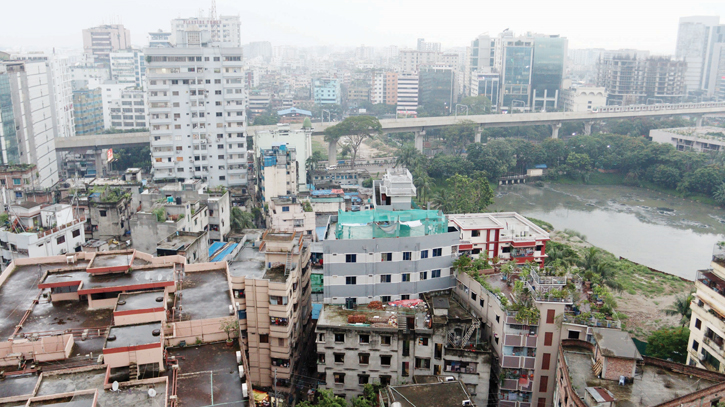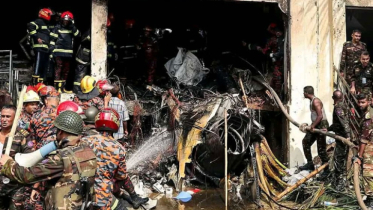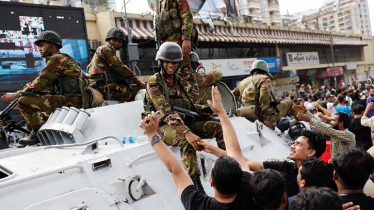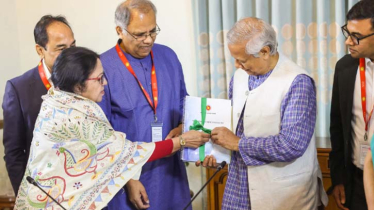
Photo : Collected
The number of unauthorised buildings in the capital is increasing every year. In the areas under the jurisdiction of the Rajdhani Unnayan Kartripakkha (RAJUK), 90 percent of those who have received approval do not have occupancy certificates. As a result, accidents often occur in these buildings, which are constructed with deviations in design, and the risk of loss of life is also increasing.
Building owners are not complying with the approved designs from RAJUK. RAJUK said they issue an average of 5,000 notices a year to control deviations in these buildings. Last year, RAJUK conducted eviction operations in 1,890 buildings to prevent deviations.
According to the detailed area plan (DAP) survey data of RAJUK gazetted in 2022, there are about 21.45 lakh buildings in the RAJUK area. Among them, there are 5.17 lakh one-story to multi-story buildings. Of these buildings, only 2 lakh have permission, while the remaining 3.17 lakh buildings have no permission.
Additionally, more than 16 lakh semi-paved buildings are also illegal. The area covered by RAJUK is 1,528 square kilometres. This includes 305 square kilometres of the two City Corporations of Dhaka, Savar Upazila, Keraniganj Upazila, Narayanganj, Bhulta, and Gauchia.
According to RAJUK sources, the areas with illegal buildings in the two cities include Demra, Basila, Dhaka Udyan, Kamrangirchar, Sarulia, Nasirabad, Dumni, Uttarkhan, Dakkhinkhan, Harirampur, Bhatara, Badda, and Old Dhaka. Outside the two city corporations of Dhaka, hundreds of buildings have been built illegally in Savar, Keraniganj, Bhulta, Gauchia, and Narayanganj areas.
It is known that about fifty residential areas have been built in Keraniganj in the name of housing projects without any approval from RAJUK. According to the Metropolitan Building Construction Regulations, an occupancy certificate must be obtained from RAJUK before living in or using a building. However, since the introduction of this law in 2008, fewer than 10 percent of the buildings have obtained this certificate.
According to urban experts, it is not possible to monitor whether buildings are being constructed according to the approved design without occupancy certificates. Even if a building owner irregularly changes the design, it is not detected. As a result, the building becomes vulnerable, but this vulnerability is not identified. Although RAJUK could take legal action if a building use certificate is not obtained, there is no precedent for taking action against anyone so far.
Bangladesh Institute of Planners (BIP) President Urbanist Adil Mohammad Khan told The Daily Messenger that due to the lack of proper implementation of the Building Act, unauthorised, illegal, and reservoir-filled buildings have been constructed in Dhaka. In this case, there is indifference and negligence on RAJUK's part in the effective application of the law. It is not possible to build a liveable Dhaka metropolis without the implementation of the Building Act.
Several related officials of RAJUK said that it is not possible for RAJUK to demolish thousands of illegal buildings and bring the construction work in order. That's why RAJUK wants to legalise the illegal buildings. DAP has a proposal for that. In light of that, the work of formulating a policy is ongoing.
They said that RAJUK has taken the initiative of creating four categories to legalise illegal buildings. Those who have constructed buildings following the National Building Code will get building approval with a small fine. For those who have a higher rate of violations of building permits and construction laws, the fines will be higher. Also, no rules will be followed for buildings constructed by filling water bodies or violating too many rules.
On the other hand, RAJUK is considering appointing a 'Third Party Entry (TPE)' to prevent accidents and ensure construction of buildings in Dhaka as per design. For this, the organization will review all relevant laws and regulations and prepare guidelines. By verifying the fitness of buildings through TPE, they will determine if a building is at risk and recommend retrofitting or rebuilding.
Regarding these matters, Ashraful Islam, the chief city planner of RAJUK, said that 90 percent of buildings have deviated from their approved designs during construction. Only about 2 lakh buildings have been built in the RAJUK area with design approval.
He further said that from RAJUK's perspective, many unauthorised buildings have been given permission by UPs and municipalities. After the Rana Plaza collapse, the government issued a directive that development authorities will give approval where there are development authorities. However, it can be seen in various places that municipalities are giving approval, but they don't have any authorized officers.
Meanwhile, according to court sources, only 12 cases have been filed under the Building Act from 2019 to March this year. Among them, 5 cases have been registered in Dakkhinkhan Police Station, 2 in Kotwali Police Station, 1 in Bangshal, 1 in Jatrabari, 1 in Shyampur, 1 in Sutrapur, and 1 in Kadomtoli.
Regarding this, Supreme Court lawyer Khurshid Alam Khan told The Daily Messenger that if even one of the 12 cases had resulted in exemplary punishment, it would have set a precedent. The government should be stricter about this.
He also said that people have died and been injured in building accidents. The cases filed are merely for show. Later, these cases never see the light of day. Overall, there is a lack of monitoring in these areas.
Messenger/Fameema








